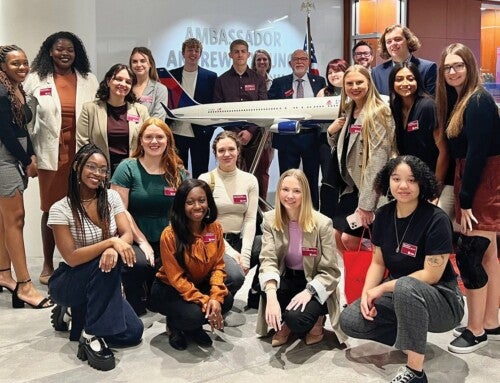
Nothing about the students filing into Professor Michael Flynn’s lecture hall on this early afternoon seems particularly unusual. They have that carefree bounce that is characteristic of college students in the spring. Clutching backpacks and reusable water bottles, and wearing shorts and T-shirts, they show no obvious trepidation about the extraordinarily difficult task before them.
Even Flynn, chair of the College’s Department of Health and Human Performance, seems serene. Dressed casually in a Cooper River Bridge Run T-shirt and jogging pants, he smiles pleasantly as the students settle into their seats.
Then, Flynn’s face turns serious, and the unique focus of the course reveals itself as his lecture begins: “If you are not doing your long run by now,” Flynn warns the students, “the marathon is going to pay you back.”
The “marathon” is the Country Music Marathon in Nashville, Tenn. The “pay you back” is the physical punishment the marathon will mete out to those who are not adequately prepared to run its hilly, 26.2-mile course. With less than one month to go before the marathon in April, Flynn is determined to not let that happen. Sure, his students will experience pain like never before. At times, they’ll want to stop, wish they were dead, and ask themselves why they signed up for this hell.
But Flynn is confident they’ll get through it. He scrutinized these students carefully before the semester, asking them tough questions: Are they willing to make the commitment? Purchase the proper equipment? Do the training? He stresses that the course is real, not merely a “running class.” In fact, students are not graded on how fast they run the marathon or even on whether they finish it. Instead, students gain a working knowledge of physiology, sport nutrition, training adaptations and other topics that will aid them as they train.
When Flynn came to the College in 2009 and brought this marathon class with him, he did so knowing full well that his academic background was likely to be overshadowed by the provocative nature of his favorite course. “I guess the people in my profession know me for my research, and that’s good enough. If I’m known as the marathon professor in Charleston, that’s OK with me.”
Last fall, he sent an e-mail to campus announcing Sport Physiology and Marathon Training as a special-topics course. More than 100 replies from interested students flooded his Inbox. He eventually whittled the class roster to about 40, favoring seniors with lighter course loads, runners with established mileage bases and those who had always aspired to complete a marathon.
Back in the lecture hall, Flynn is discussing environmental extremes and fluid balance and how they influence running performance. His students have completed training runs in bitter cold, howling wind and pouring rain. But now it’s getting warmer outside, and they are realizing that heat and humidity could be their biggest threats in Nashville.
As the big day draws closer, the students assess their goals for the marathon. Some aspire only to cross the finish line. Others have specific time targets. All have gained confidence and endurance through four months of consistent, structured training. At the beginning of the semester, 26.2 miles seemed unattainable to many. But as their long runs gradually increased in distance week after week – 12, 14, 16, 18, 20 miles – the marathon milestone moved increasingly within their grasp.
“The biggest surprise I’ve had so far was running 20 miles and feeling great the whole way,” Bobby Joly, a communication major, says of a recent training run. “I never thought I would be able to do it.”
While mileage gains have helped the students believe in their own abilities, the classroom lectures have provided an invaluable base of knowledge. As their bodies endure stress and injuries, the students better understand what’s occurring and why.
During labs, the class has dabbled in the geekier areas of running science. Flynn has taught them how to calculate sweat loss, how to measure and assess their body compositions and how to test the body’s oxygen-consuming capacity.
All of the lectures and labs hit home for the students in the throes of a long run. Soaked in sweat, legs aching, chests heaving, stomachs churning – they experiment on themselves. “My goal was to develop a course where students would learn while using their own bodies as a laboratory,” Flynn says.
Still, there are limits to what books and science can teach students about running a marathon. There’s no equal for the firsthand, practical experience Flynn has gained from having run several marathons. He understands the marathon’s allure, its life-changing power and its unforgiving lessons. He grew up near Boston, the mecca of marathon running, and took up running when the sport first boomed in the 1970s. In his mid-20s, he turned in an impressive sub-three-hour marathon, and in his mid-40s he twice qualified for and ran the Boston Marathon.
Doctoral work in human bioenergetics and the births of three boys pushed running aside for a while, but it has been a constant companion most of his life. He runs just about every day, often during his lunch break.
Over the course of the semester, Flynn wears many hats: professor, coach, counselor, cheerleader, trainer, friend. “Doctor Flynn” sounds too formal a title when the class is grinding through a 17-miler. So his students call him “Mick.”
The final class before the Nashville Marathon is devoted to last-minute preparations and logistics. They cover pacing, chafing, waterproofing and hydration. Weather is still a big concern. The latest forecast for Nashville calls for highs in the upper 70s and scattered thunderstorms. A student asks if organizers would cancel the marathon because of thunderstorms. Though he says that would be unlikely, Flynn recalls that the 2010 Myrtle Beach Marathon was cancelled due to snow. Marathons, like life, are unpredictable.
Marathon day dawns deceivingly sunny and beautiful in Nashville. But there’s talk of bad weather on the horizon. Race organizers move up the start time by 15 minutes in an effort to get more runners through the course before the weather turns ugly.
As the marathon gets under way, many of the students quickly come to two realizations: The first is that there are A LOT of runners participating (30,000 between the full and half marathon). The other reality check is that the course is much hillier than they expected (thank heavens for those training runs over Charleston’s Ravenel Bridge!).
Throughout the semester, Flynn has cautioned students about the proverbial “wall” that many runners hit in the latter miles. For Joly, this occurs at Mile 23. He can no longer feel his legs. His tank is bone dry. A hill looming ahead could deliver the knockout blow. “But I pushed through it with the thought that I only had three miles to go and that if I stopped, how disappointed I’d be with myself.”
Joly would go on to complete the marathon in three hours, 50 minutes – achieving his goal of finishing under four hours. But the worsening weather – including the threat of tornados – forces the marathon’s organizers to cut the race short for runners further back in the pack. It’s a shocking and crushing development for Flynn and his students.
Among the College contingent, only Joly and one other student are allowed to complete the course. Three students reluctantly end their quest at the halfway point, and the rest of the class, along with thousands of other runners, are stopped at Mile 23 – just three miles and 385 yards shy of the finish line.
“I was confused and frustrated,” says Kelsi Ward, a senior political science major. “But I was ecstatic to have done well and run the whole time and thrilled to be a part of such an awesome experience.”
That same positive attitude was echoed by all of Flynn’s students in spite of the unbelievably disappointing circumstances that befell them in Nashville.
Back in Charleston, the class gathers one last time for a debriefing and goodbyes. Flynn is emotional. He says this class was the best prepared of any he has taught.
“The way you all responded really made me proud,” Flynn says. “You handled an impossibly difficult situation with class.”
But no one likes unfinished business. Many of the students immediately make plans to run other marathons. Some map out their own courses traversing the Lowcountry. A couple travel to marathons in other states. Several set their sights on the inaugural Charleston Marathon in January 2011.
Flynn is blown away by the whole experience. Through decades of teaching and running, he thought he’d seen just about everything in the unpredictable orbits of college students and marathons. He was reminded of the marathon’s power to teach life lessons and humbled by the resiliency of young people in the face of adversity.




